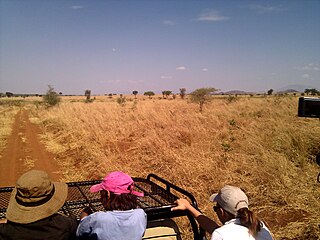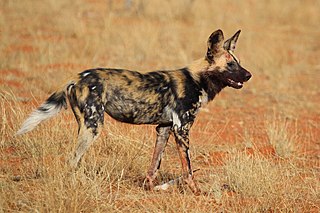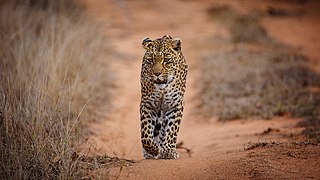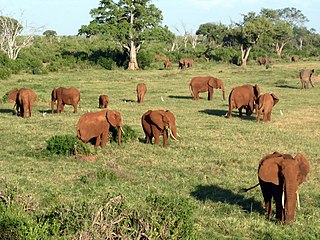Kgosi Lucas Manyane Mangope was the leader of the Bantustan (homeland) of Bophuthatswana. The territory he ruled over was distributed between the Orange Free State - what is now Free State - and North West Province. He was also the founder and leader of the United Christian Democratic Party, a political party based in the North West of South Africa.

Gonarezhou National Park is a national park located in southeastern Zimbabwe. It is situated in a relatively remote corner of Masvingo Province, south of Chimanimani along the Mozambique border. Owing to its vast size, rugged terrain and its location away from main tourist routes, large tracts of Gonarezhou remain pristine wilderness.

Great Limpopo Transfrontier Park is a 35,000 km² peace park that is in the process of being formed. It will link the Limpopo National Park in Mozambique, Kruger National Park in South Africa, Gonarezhou National Park, Manjinji Pan Sanctuary and Malipati Safari Area in Zimbabwe, as well as the area between Kruger and Gonarezhou, the Sengwe communal land in Zimbabwe and the Makuleke region in South Africa.

Kilimanjaro Safaris is a safari attraction at Disney's Animal Kingdom on the Walt Disney World Resort property in Lake Buena Vista, Florida. It simulates an open-sided safari ride through the savanna of East Africa.

Kidepo Valley National Park is a 1,442 square kilometres (557 sq mi) national park in the Karamoja region in northeast Uganda. Kidepo is rugged savannah, dominated by the 2,750 metres (9,020 ft) Mount Morungole and transected by the Kidepo and Narus rivers.

The Madikwe Game Reserve is a protected area in South Africa, part of the latest park developments in the country. Named after the Madikwe or Marico River, on whose basin it is located, it was opened in 1991 and comprises 750 km² of bushland north of the small town Groot-Marico up to the Botswana border.

The East Sudanian Savanna is a hot, dry, tropical savanna ecoregion of Central and East Africa.

The Pilanesberg is a mountain in the North West Province, South Africa. The mountain is an ancient volcanic structure, circular in shape, that rises from flat surrounding plains. It is formed by three concentric ridges or rings of hills, of which the outermost has a diameter of about 24 km. The Pilanesberg is located 100 km to the North-West of Pretoria and is for the greater part enclosed in a protected area known as Pilanesberg Game Reserve.

The wildlife of Botswana refers to the flora and fauna of Botswana. Botswana is around 90% covered in savanna, varying from shrub savanna in the southwest in the dry areas to tree savanna consisting of trees and grass in the wetter areas. Even under the hot conditions of the Kalahari Desert, many different species survive; in fact the country has more than 2500 species of plants and 650 species of trees. Vegetation and its wild fruits are also extremely important to rural populations living in the desert and are the principal source of food, fuel and medicine for many inhabitants.

The wildlife of Chad is composed of its flora and fauna.

The Timbavati Private Nature Reserve is located at the border line between Hoedspruit and Acornhoek, north of the Sabi Sand Private Game Reserve on the western edge of Kruger National Park. Geographically and politically, Timbavati is located in Mpumalanga Province. In Xitsonga, the name 'Timbavati' means "the place where something sacred came down to Earth from the Heavens", and refers to the rare white lions of Timbavati.

The wildlife of Somalia includes the flora and fauna of Somalia, which is extremely diverse due to the country's location between the temperate and the tropical zones. Somalia has a long coastline, bordered by the Indian Ocean in the east and Red Sea in the north. The Northwestern and Central parts of the country are arid, or very dry. The Southern and Northeastern regions are semi-arid, receiving slightly more rainfall than the Central and Northwest regions. The Coastal region is more humid due to its proximity to the ocean. Somalia is home to over 727 species of birds and boasts over 177 species of mammals.
The North West Parks Board is a governmental organisation responsible for the management of protected areas and public nature reserves in North West Province, South Africa.

The African wild dog also called the African painted dog and the African hunting dog, is a wild canine which is a native species to sub-Saharan Africa. It is the largest wild canine in Africa, and the only extant member of the genus Lycaon, which is distinguished from Canis by dentition highly specialised for a hypercarnivorous diet, and by a lack of dewclaws. It is estimated that about 6,600 adults live in 39 subpopulations that are all threatened by habitat fragmentation, human persecution, and outbreaks of disease. As the largest subpopulation probably comprises fewer than 250 individuals, the African wild dog has been listed as endangered on the IUCN Red List since 1990.
Erindi Private Game Reserve is a protected reserve in Namibia, located southeast of Omaruru. It is a private game reserve located on a central plateau in Namibia, just three hours north of Windhoek. The reserve rests in between the towns of Otjiwarongo, Omaruru and Okahandja. The land on which Erindi was founded, has been reclaimed as part of a massive rehabilitation and conservation venture. The owners, Chris and Gert Joubert, originally bought the 70 719 hectares of land with the intention of going into cattle farming. It was soon realized that farming cattle is an extremely costly practice, and they abandoned the idea in favor of a private game reserve. The aim was to restore endemic species to the area, with the hope that they would once again thrive there.
Parliamentary elections were held in Bophuthatswana on 4 October 1972. The Bophuthatswana National Party led by Lucas Mangope won 20 of the 24 elected seats in the Legislative Assembly.

Sabi Sand Game Reserve is located adjacent to the Kruger National Park in the Lowveld of Mpumalanga, South Africa. Officially named Sabi Sand Wildtuin, the Sabi Sand Game Reserve consists of a group of private game reserves. The Newington Gate is at 24°52′9″S31°24′16″E and west of the Kruger Gate and Skukuza camp of Kruger Park. Other entrances are Gowrie Gate in the far north and Shaws Gate in the south.

Mapesu Private Game Reserve is a game reserve in Limpopo Province, South Africa. The reserve adjoins the Mapungubwe National Park and World Heritage Site, with which it shares a 12.5 km Northern border. The main entrance gate to the reserve is located approximately 7 km east of Mapungubwe's entrance gate. It was established in 2014 and covers an area of over 7,200 hectares. The reserve protects various bird, mammal and tree species and is slated to become part of the Greater Mapungubwe Transfrontier Conservation Area in phase 2 as part of the proposed Limpopo Valley Game Reserve.

The Southern Acacia–Commiphora bushlands and thickets is a tropical grasslands, savannas, and shrublands ecoregion in Tanzania and Kenya. It includes portions of Serengeti National Park and Ngorongoro Conservation Area, which are designated World Heritage Sites and biosphere reserves for their outstanding wildlife and landscapes. It is one of three Acacia–Commiphora bushlands and thickets ecoregions in eastern Africa.

The Northern Acacia–Commiphora bushlands and thickets are a tropical grasslands, savannas, and shrublands ecoregion in eastern Africa. The ecoregion is mostly located in Kenya, extending north into southeastern South Sudan, northeastern Uganda, and southwestern Ethiopia, and south into Tanzania along the Kenya-Tanzania border.




























